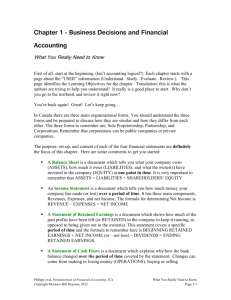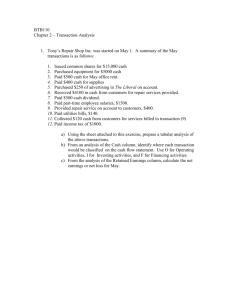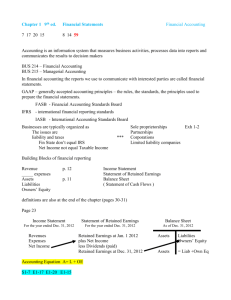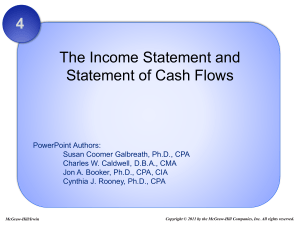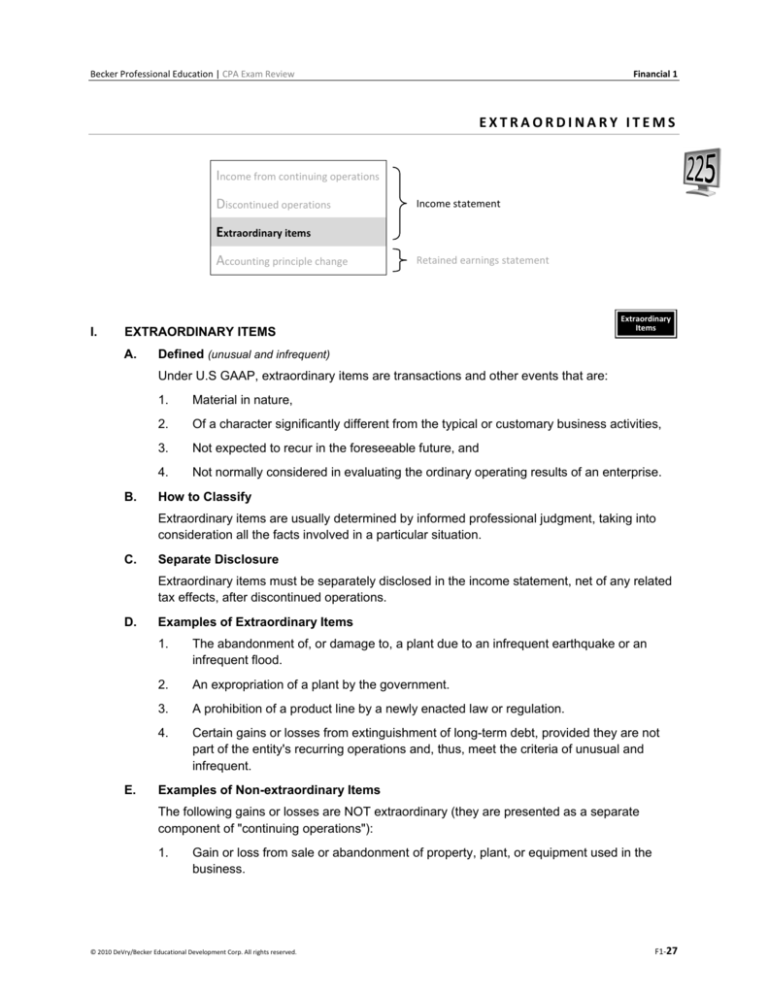
Becker Professional Education | CPA Exam Review
Financial 1
EXTRAORDINARY ITEMS
Income from continuing operations
Discontinued operations
Income statement
Extraordinary items
Accounting principle change
I.
Retained earnings statement
EXTRAORDINARY ITEMS
A.
Extraordinary
Items
Defined (unusual and infrequent)
Under U.S GAAP, extraordinary items are transactions and other events that are:
B.
1.
Material in nature,
2.
Of a character significantly different from the typical or customary business activities,
3.
Not expected to recur in the foreseeable future, and
4.
Not normally considered in evaluating the ordinary operating results of an enterprise.
How to Classify
Extraordinary items are usually determined by informed professional judgment, taking into
consideration all the facts involved in a particular situation.
C.
Separate Disclosure
Extraordinary items must be separately disclosed in the income statement, net of any related
tax effects, after discontinued operations.
D.
E.
Examples of Extraordinary Items
1.
The abandonment of, or damage to, a plant due to an infrequent earthquake or an
infrequent flood.
2.
An expropriation of a plant by the government.
3.
A prohibition of a product line by a newly enacted law or regulation.
4.
Certain gains or losses from extinguishment of long-term debt, provided they are not
part of the entity's recurring operations and, thus, meet the criteria of unusual and
infrequent.
Examples of Non-extraordinary Items
The following gains or losses are NOT extraordinary (they are presented as a separate
component of "continuing operations"):
1.
Gain or loss from sale or abandonment of property, plant, or equipment used in the
business.
© 2010 DeVry/Becker Educational Development Corp. All rights reserved.
F1-27
Financial 1
Becker Professional Education | CPA Exam Review
2.
II.
Large write-downs or write-offs of:
a.
Receivables.
b.
Inventories.
c.
Intangibles (including goodwill).
d.
Long-term securities (permanent decline).
3.
Gain or loss from foreign currency transactions or translation, whether from major
devaluations or otherwise (provided these occur on a regular basis as part of normal
business operations).
4.
Losses from major strike by employees.
5.
Long-term debt extinguishments that are part of a common management strategy (i.e.,
not unusual and infrequent).
MATERIAL UNUSUAL OR INFREQUENT ITEMS
Items of income or loss that are either unusual or infrequent are not extraordinary (e.g., gain on the
sale of a factory building). If material, these items should be reported as a separate line item as
part of income from continuing operations (and not net of tax). The nature of the item and the
financial effects should be disclosed on the face of the income statement or in the footnotes.
U. S. G A A P v s. I F R S
IFRS prohibits the reporting of any amount as extraordinary on the income statement or in the notes to the financial
statements.
F1-28
©2010 DeVry/Becker Educational Development Corp. All rights reserved.
Becker Professional Education | CPA Exam Review
Financial 1
ACCOUNTING CHANGES AND ERROR CORRECTIONS
Income from continuing operations
Discontinued operations
Income statement
Extraordinary items
Accounting principle change
I.
Retained earnings statement
Accounting
Changes
GENERAL
Accounting changes are broadly classified as:
(i)
Changes in accounting estimate,
(ii)
Changes in accounting principle, and
(iii)
Changes in accounting entity.
Note that error corrections are not considered accounting changes.
Accounting
Estimates
II.
CHANGES IN ACCOUNTING ESTIMATE (prospective)
A change in accounting estimate occurs when it is determined that the estimate previously used by
the company is incorrect.
A.
Events Resulting in Estimate Changes
1.
Changes in the lives of fixed assets.
2.
Adjustments of year-end accrual of officers' salaries and/or bonuses.
3.
Write-downs of obsolete inventory.
4.
Material non-recurring IRS adjustments.
5.
Settlement of litigation.
6.
Changes in accounting principle that are inseparable from a change in estimate (e.g., a
change from the installment method to immediate recognition method because
uncollectible accounts can now be estimated).
EXAMPLE
Carlin Company buys a truck for $90,000. The truck is expected to last 10 years. During the third year, Carlin
Company realizes that the truck is only going to last a total of 5 years. The truck is depreciated on the
straight-line basis and has no estimated salvage value.
DEPRECIATION SCHEDULE ILLUSTRATION
Year
1
2
3
4
5
© 2010 DeVry/Becker Educational Development Corp. All rights reserved.
Depreciation
$9,000 [$90,000/10]
$9,000 [$90,000/10]
$24,000 [$72,000/3]
$24,000 [$72,000/3]
$24,000 [$72,000/3]
$90,000
F1-29
Financial 1
B.
Becker Professional Education | CPA Exam Review
Reporting a Change in Estimate
1.
Prospectively
Changes in accounting estimate are accounted for prospectively (i.e., implement in the
current period and continue in future periods). They do not affect previous periods (i.e.,
no effect on previously reported retained earnings).
2.
Change in Estimate Affecting Future Periods
If a change in accounting estimate affects several future periods (e.g., a revision of
service lives of depreciable assets), the effect on income before extraordinary items,
net income, and the related per share information for the current year should be
disclosed in the notes to the financial statements.
Note: Changes in ordinary accounting estimates (e.g., uncollectible accounts and inventory
adjustments) usually made each period do not have to be disclosed unless they are material.
Changes in
Accounting Principle
III.
CHANGES IN ACCOUNTING PRINCIPLE (retrospective application)
A change in accounting principle is a change in accounting from one accounting principle to
another acceptable accounting principle (i.e., GAAP to GAAP or IFRS to IFRS).
A.
Rule of Preferability
An accounting principle may be changed only if required by GAAP/IFRS or if the alternative
principle is preferable and more fairly presents the information.
B.
Nonrecurring Changes
An accounting change should not be made for a transaction or event in the past that has
been terminated or is nonrecurring.
C.
Effects of a Change
1.
Direct Effects
The direct effects of a change in accounting principle are adjustments that would be
necessary to restate the financial statements of prior periods.
2.
Indirect Effects
The indirect effects of a change in accounting principle are differences in
nondiscretionary items based on earnings (e.g., bonuses) that would have occurred if
the new principle had been used in prior periods.
3.
Cumulative Effect
If non-comparative financial statements are being presented, then the cumulative effect
of a change in accounting principle is equal to the difference between the amount of
beginning retained earnings in the period of change and what the retained earnings
would have been if the accounting change had been retroactively applied to all prior
affected periods. It includes direct effects and only those indirect effects that are
entered in the accounting records. If comparative financial statements are being
presented, then the cumulative effect is equal to the difference between beginning
retained earnings in the first period presented and what retained earnings would have
been if the new principle had been applied to all prior periods.
F1-30
©2010 DeVry/Becker Educational Development Corp. All rights reserved.
Becker Professional Education | CPA Exam Review
Financial 1
EXAMPLE – CUMULATIVE EFFECT OF A CHANGE IN ACCOUNTING PRINCIPLE
On January 1, 20X5, Harbor Construction Company decided to switch to the percentage-of-completion
method in accounting for all of its long-term construction contracts. Prior to 20X5, Harbor used the
completed contract method for some of its contracts. Harbor's effective tax rate is 30%. For income tax
purposes, Harbor continues to use the completed contract method for all its contracts.
Contract information is as follows:
Prior to 20X5
Pretax Income from
Percentage-of-Completion Completed Contract
$800,000
$600,000
Cumulative effect adjustment as of 1/1/20X5 =
Less income tax effect @ 30%
Cumulative effect net of income tax
D.
$200,000
(60,000)
$140,000
Reporting Changes in an Accounting Principle
The general rule is that changes in accounting principle should be recognized by adjusting
beginning retained earnings in the earliest period presented for the cumulative effect of the
change, and, if prior period financial statements are presented, they should be restated
(retrospective application).
U. S. G A A P v s. I F R S
Under IFRS, when an entity disclosing comparative information applies an accounting principle retroactively
or makes a retrospective restatement of items in the financial statements, the entity must (at a minimum)
present three balance sheets (end of current period, end of prior period, and beginning of prior period) and
two of each other financial statement (current period and prior period). The cumulative effect adjustment
would be shown as an adjustment of the beginning retained earnings on the balance sheet for the beginning
of the prior period. U.S. GAAP does not have a three balance sheet requirement.
1.
Exceptions to the General Rule
a.
Impracticable to Estimate
To prepare a change in accounting principle handled retrospectively, the amount
of the cumulative effect adjustment must be calculated as of the beginning of the
first period presented. If it is considered "impractical" to accurately calculate this
cumulative effect adjustment, then the change is handled prospectively (like a
change in estimate). An example of a change handled in this manner is a
change in inventory cost flow assumption to LIFO (under U.S. GAAP). Since a
cumulative effect adjustment to LIFO would require the reestablishment and
recalculation of old inventory layers, it is considered impractical to try and rebuild
those old cost layers. This change is therefore handled prospectively. The
beginning inventory of the year of change is the first LIFO layer. Additional LIFO
layers are added on from that point forward.
© 2010 DeVry/Becker Educational Development Corp. All rights reserved.
F1-31
Financial 1
Becker Professional Education | CPA Exam Review
b.
Change in Depreciation Method
A change in the method of depreciation, amortization, or depletion is considered
to be both a change in accounting principle and a change in estimate. These
changes should be accounted for as changes in estimate and are handled
prospectively. The new depreciation method should be used as of the beginning
of the year of the change in estimate and should start with the current book value
of the underlying asset. No retroactive or retrospective calculations should be
made, and no adjustment should be made to retained earnings.
2.
Applications of the General Rule
a.
(1)
Retained earnings at the beginning of the earliest period presented, and
(2)
Retained earnings that would have been reported at the beginning of the
earliest period presented if the new accounting principle had been applied
retrospectively for all prior periods, by recognizing only the direct effects
and related income tax effect.
b.
The new accounting principle is used for all periods presented (prior periods are
restated).
c.
If an accounting change is not considered material in the year of change but is
reasonably expected to become material in later periods, it should be fully
disclosed in the year of change.
Changes in
Accounting Entity
IV.
The amount of cumulative effect to be reported on the retained earnings
statement is the difference between:
CHANGES IN ACCOUNTING ENTITY (retrospective application)
Under U.S. GAAP, a change in accounting entity occurs when the entity being reported on has
changed composition. Examples include consolidated or combined financial statements that are
presented in place of statements of the individual companies and changes in the companies
included in the consolidated or combined financial statements from year to year.
A.
Restatement to Reflect Information for the New Entity (if comparative financial statements are
presented)
If a change in accounting entity occurs in the current year, all previous financial statements
that are presented in comparative financial statements along with the current year should be
restated to reflect the information for the new reporting entity.
B.
Full Disclosure
Full disclosure of the cause and nature of the change should be made, including changes in
income before extraordinary items, net income, and retained earnings.
U. S. G A A P v s. I F R S
IFRS does not include the concept of a change in accounting entity.
F1-32
©2010 DeVry/Becker Educational Development Corp. All rights reserved.
Becker Professional Education | CPA Exam Review
V.
Financial 1
ERROR CORRECTION (prior period adjustment)
Error corrections include:
Prior Period
Adjustments
(i)
Corrections of errors in recognition, measurement, presentation, or disclosure in financial
statements resulting from mathematical mistakes, mistakes in the application of U.S.
GAAP/IFRS, or oversight or misuse of facts that existed at the time the financial statements
were prepared.
(ii)
Changes from a non-GAAP/IFRS method of accounting to a GAAP/IFRS method of
accounting (e.g., cash basis to accrual basis), which is a specific correction of an error.
A.
Accounting
1.
Comparative Financial Statements Presented
a.
Correct the Information, if the Year is Presented
If comparative financial statements are presented and financial statements for
the year with the error are presented, merely correct the error in those prior
financial statements.
b.
Adjust Beginning Retained Earnings of the Earliest Year Presented, if the
Year is Not Presented
If comparative financial statements are presented and financial statements for
the year with the error are not presented (e.g., because it is too far back in
years), adjust (net of tax) the opening retained earnings of the earliest year
presented.
2.
Comparative Financial Statements Not Presented
If comparative financial statements are not presented the error correction should be
reported as an adjustment to the opening balance of retained earnings (net of tax).
U. S. G A A P v s. I F R S
Under IFRS, when it is impracticable to determine the cumulative effect of an error the entity is required to
restate information prospectively from the earliest date that is practicable. U.S. GAAP does not have an
impracticality exemption for error corrections.
© 2010 DeVry/Becker Educational Development Corp. All rights reserved.
F1-33
Financial 1
B.
Becker Professional Education | CPA Exam Review
Example Statement of Retained Earnings (with restatement effects)
The purpose of the statement of retained earnings is to reconcile the beginning balance of
retained earnings with the ending balance. It is usually presented immediately following the
income statement.
EXAMPLE
Jordan Manufacturing
Statement of Retained Earnings
For the Year Ended December 31, Year 1
Beginning balance (as previously reported)
Prior period adjustment (Note 5)
$28,000,000
$(4,500,000)
Add: Income tax benefit
1,800,000
Cumulative effect of accounting change
5,000,000
Less: Income tax effect
(2,000,000)
Beginning balance (restated)
(2,700,000)
3,000,000
28,300,000
Add: Net income
1,700,000
30,000,000
Less: Dividends
Cash dividend declared on preferred stock
500,000
Cash dividend declared on common stock
350,000
Property dividend declared on common stock
100,000
Stock dividend declared on common stock
Ending balance
F1-34
50,000
(1,000,000)
$29,000,000
©2010 DeVry/Becker Educational Development Corp. All rights reserved.
Becker Professional Education | CPA Exam Review
Financial 1
COMPREHENSIVE INCOME
Pension adjustments
Unrealized gains and losses (available-for-sale securities)
Foreign currency items
Effective portion cash flow hedges
Revaluation surplus (IFRS only)
I.
DEFINITIONS
A.
Comprehensive Income
Comprehensive
Income
Comprehensive income is the change in equity (net assets) of a business enterprise during a
period from transactions and other events and circumstances from non-owner sources. It
includes all changes in equity during a period except those resulting from investments by
owners and distributions to owners.
Net income
+ Other comprehensive income
Comprehensive income
B.
Net Income
Net income includes the following items:
C.
1.
Income from continuing operations
2.
Discontinued operations
3.
Extraordinary items
Other Comprehensive Income
Other comprehensive income items are revenues, expenses, gains, and losses that are
included in comprehensive income but excluded from net income under U.S. GAAP and/or
IFRS.
An entity must classify the specific items by their nature, such as:
1.
Pension Adjustments
Under U.S. GAAP, changes in the funded status of a pension plan due to gains or
losses, prior service costs, and net transition assets or obligations must be recognized
in other comprehensive income in the year the changes occur. All gains or losses,
prior service costs, and transition assets or obligations are included in other
comprehensive income until recognized as a component of net periodic benefit cost.
(Pensions are covered in detail in lecture F-6, later in the course.)
Under IFRS, certain actuarial gains and losses may be included in other
comprehensive income. These gains and losses are not reclassified to the net income
in subsequent periods.
© 2010 DeVry/Becker Educational Development Corp. All rights reserved.
F1-35
Financial 1
Becker Professional Education | CPA Exam Review
2.
Unrealized Gains and Losses (available for sale securities)
The following types of unrealized gains and losses on certain investments in debt and
equity securities are reported as components of other comprehensive income until the
securities are sold. (All are covered in detail in lecture F-3, later in the course.)
3.
a.
Unrealized holding gains and losses on "available-for-sale securities."
b.
Unrealized holding gains and losses that result from a debt security being
transferred into the "available-for-sale" category from "held-to-maturity."
c.
Subsequent decreases or increases in the fair value of "available-for-sale"
securities previously written down as impaired.
Foreign Currency Items
Foreign currency translation adjustments and gains and losses on foreign currency
transactions that are designated as (and are effective as) economic hedges of a net
investment in a foreign entity (discussed in the F-7 lecture on derivatives and other
financial instruments) are reported as a component of other comprehensive income.
Foreign currency translation adjustments remain in other comprehensive income until
the sale or liquidation of the investment in the foreign entity. (Foreign currency and its
related effects are covered in detail in lecture F-2, later in the course.)
4.
Effective Portion of Cash Flow Hedges
The effective portion of a cash flow hedge is reported as a component of other
comprehensive income until the cash flows associated with the hedged item are
realized. (Cash flow hedges are discussed in the F-7 lecture on derivatives and other
financial instruments.)
5.
Revaluation Surplus (IFRS only)
Under IFRS, revaluation surpluses (gains) recognized when intangible assets and fixed
assets are revalued, are also included in other comprehensive income. Revaluation
surpluses are not reclassified to net income in subsequent periods, but may be
transferred directly to retained earnings when the related asset is used or
derecognized. (The revaluation of intangible assets is discussed in the F-2 lecture and
the revaluation of fixed assets is discussed in the F-4 lecture.)
D.
Reclassification Adjustments
Reclassification adjustments move other comprehensive income items from accumulated
other comprehensive income to the income statement. These adjustments may be displayed
on the face of the financial statement in which comprehensive income is reported or
disclosed in the notes to the financial statements.
E.
Accumulated Other Comprehensive Income
Accumulated other comprehensive income is a component of equity that includes the total of
other comprehensive income for the period and previous periods. Other comprehensive
income for the current period is "closed" to this account, which is reconciled each period
similar to the manner in which retained earnings are reconciled.
PASS KEY
At the end of each accounting period, all components of comprehensive income are closed to the balance
sheet. Net income is closed to retained earnings and other comprehensive income is closed to accumulated
other comprehensive income.
F1-36
©2010 DeVry/Becker Educational Development Corp. All rights reserved.
Becker Professional Education | CPA Exam Review
II.
Financial 1
FINANCIAL STATEMENT REPORTING
Comprehensive income and its components shall be displayed in a financial statement that is
presented with the same prominence as the other financial statements that constitute a full set of
financial statements. The requirements to present comprehensive income do not apply to not-forprofit entities or to any company that does not have any item of other comprehensive income.
Comprehensive income should not be reported on a per share basis.
Under U.S. GAAP, comprehensive income may be presented in:
(i)
A single statement of comprehensive income (single-statement approach);
(ii)
An income statement followed by a separate statement of comprehensive income that begins
with net income (two-statement approach); or
(iii) A statement of changes in equity.
Statement of
Income and
Comprehensive
Income
Statement of Changes
in Stockholders' Equity
Comprehensive
Income
Option #2
Comprehensive
Income
Option #3
Option #1
U. S. G A A P v s. I F R S
Under IFRS, comprehensive income may be reported using the single-statement approach or the two-statement
approach. IFRS prohibits the presentation of comprehensive income in the statement of changes in equity.
A.
Single Statement Approach
The single statement approach displays other comprehensive income below the income
statement and totals them for comprehensive income.
EXAMPLE
Sydney Technologies, Inc.
Statement of Income and Comprehensive Income
For the Year Ended December 31, Year 1
Summarized
Revenues
Expenses
Income before income taxes
Income tax (25%)
Net income
Other comprehensive income, net of income tax:
Pension net loss
Unrealized holding gains (available-for-sale securities)
Foreign currency items
Comprehensive income
© 2010 DeVry/Becker Educational Development Corp. All rights reserved.
$20,000,000
($18,400,000)
1,600,000
(400,000)
1,200,000
($25,000)
300,000
(75,000)
200,000
$ 1,400,000
F1-37
Financial 1
B.
Becker Professional Education | CPA Exam Review
Two-statement Approach
The two-statement approach displays comprehensive income as a separate statement that
begins with net income.
EXAMPLE
Sydney Technologies, Inc.
Statement of Income and Comprehensive Income
For the Year Ended December 31, Year 1
Net income
$1,200,000
Other comprehensive income, net of income tax
Pension net loss
Unrealized holding gains (available-for-sale securities)
Foreign currency items
Comprehensive income
C.
($25,000)
300,000
(75,000)
200,000
$1,400,000
Component within the Statement of Owners' Equity (U.S. GAAP only)
Under U.S. GAAP, comprehensive income may be displayed as a separate column in the
statement of owners' equity. This presentation is prohibited under IFRS. Note that the
separate presentation of accumulated other comprehensive income is required as part of the
statement of owners' equity.
EXAMPLE
Sydney Technologies, Inc.
Statement of Changes in Stockholders' Equity
For the Year Ended December 31, Year 1
Total
Beginning balance
Comprehensive
income
$30,000,000
Retained
earnings
Accumulated
other comp.
income
Common
stock
$8,500,000
$1,500,000
$20,000,000
Comprehensive income:
1,200,000
$1,200,000
Pension net loss
Net income
(25,000)
(25,000)
Unrealized holding gains
300,000
300,000
Foreign currency items
(75,000)
Other comprehensive income
Dividends declared on common stock
Ending balance
(75,000)
200,000
Comprehensive income
Common stock issued
1,200,000
200,000
$1,400,000
1,000,000
1,000,000
(700,000)
(700,000)
$31,700,000
$9,000,000
OPTIONAL
FORMAT
$1,700,000
$21,000,000
REQUIRED
FORMAT
Total = $31,700,000
F1-38
©2010 DeVry/Becker Educational Development Corp. All rights reserved.

